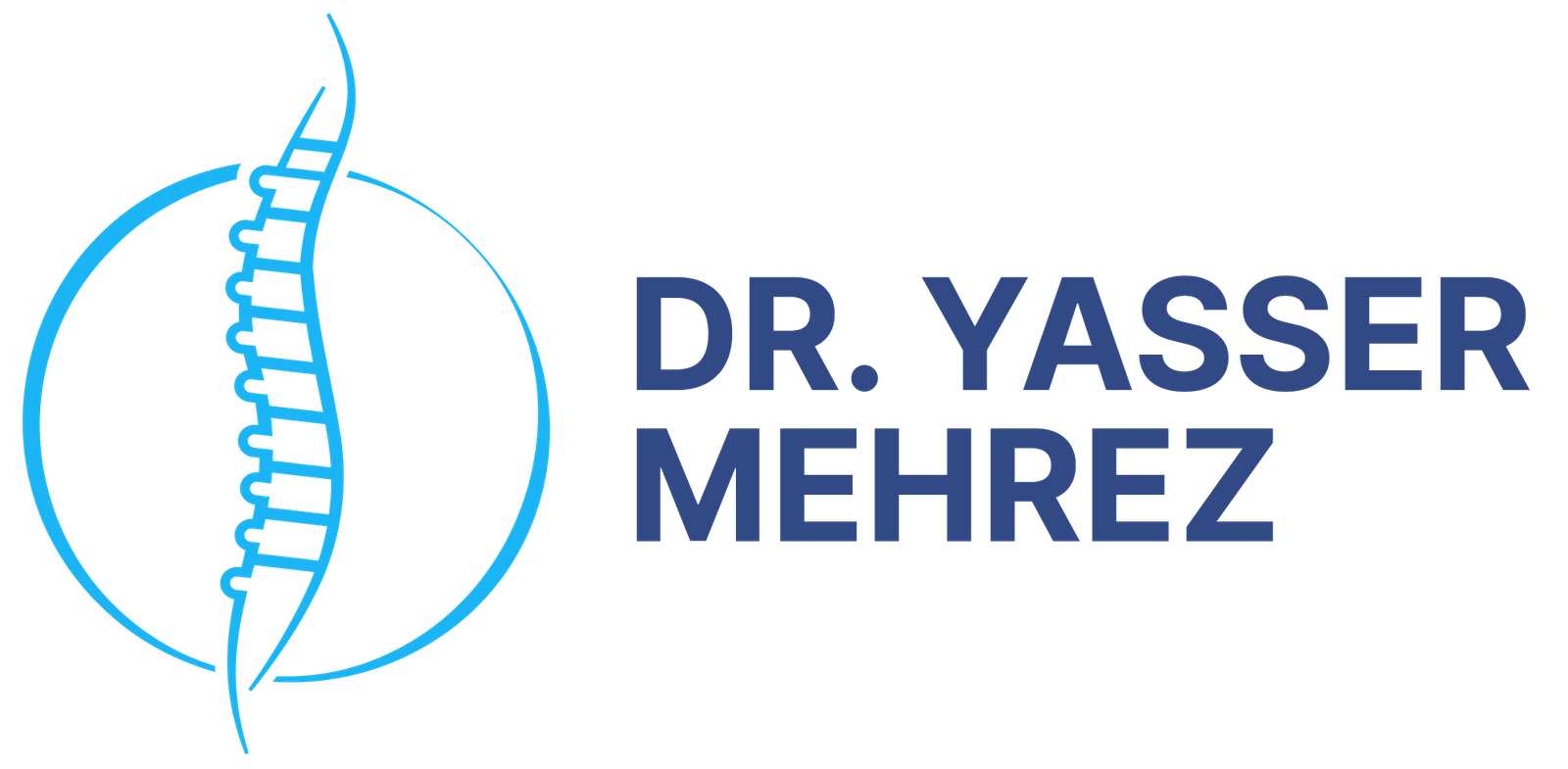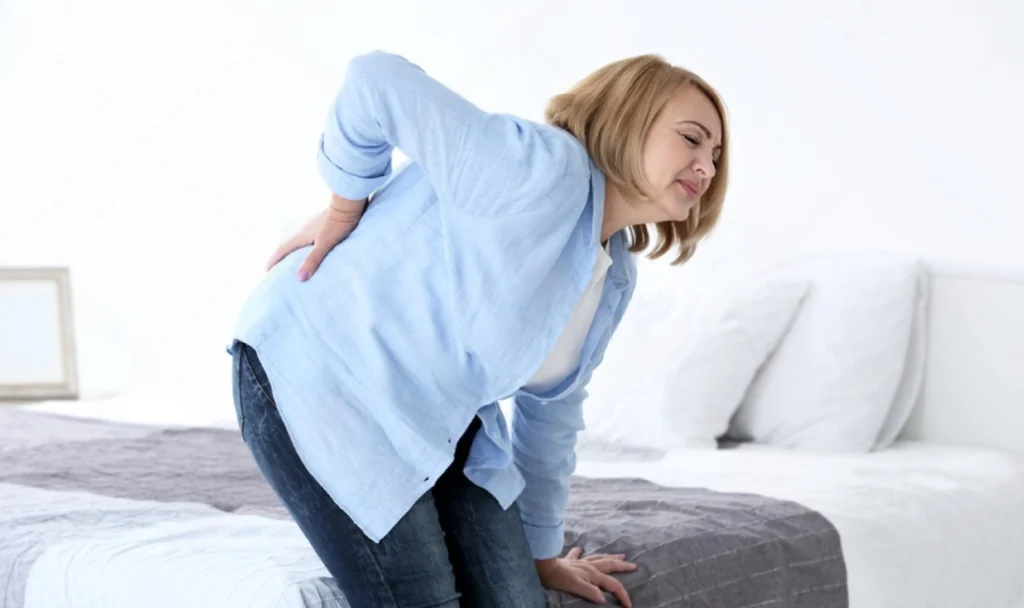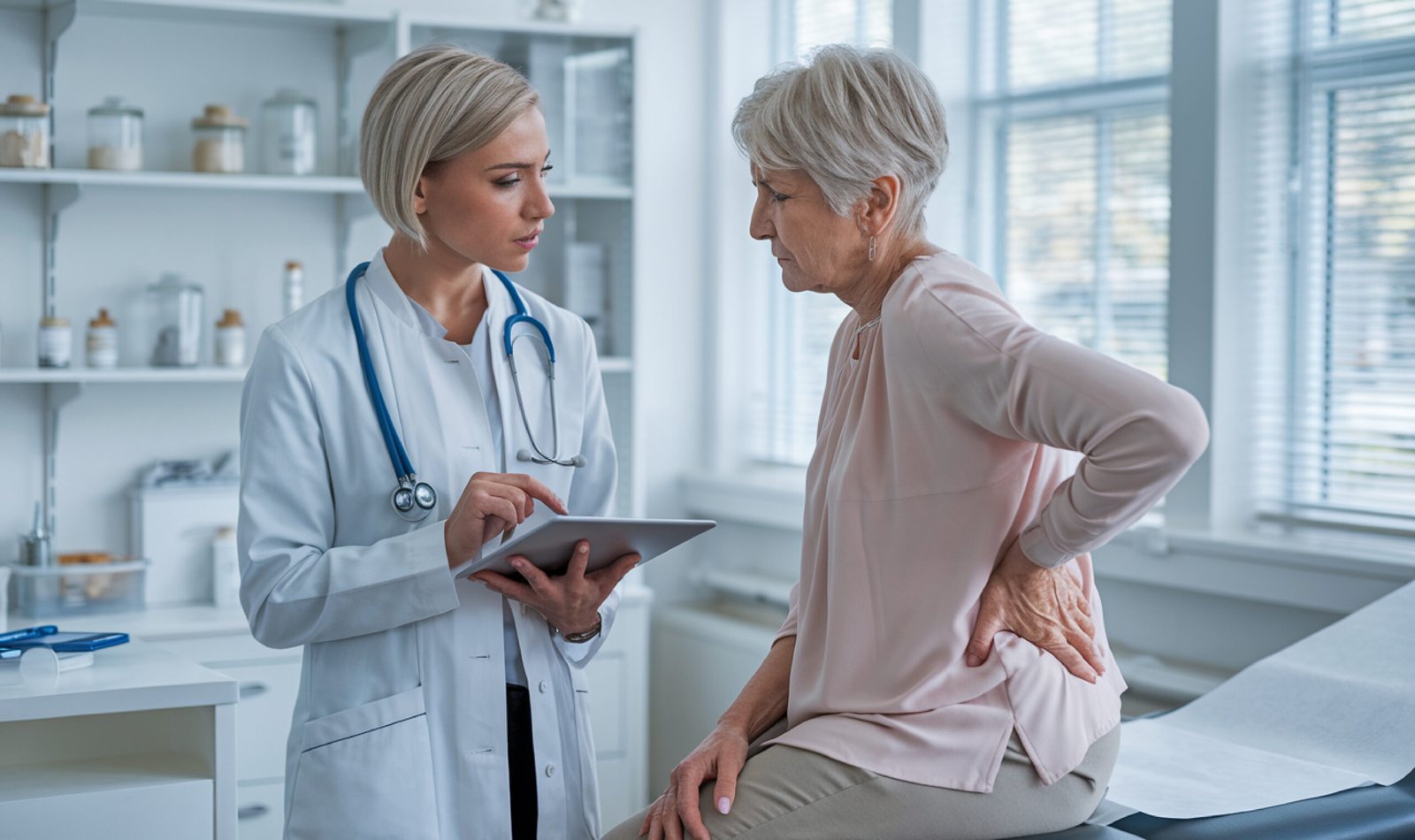Lower back pain happens to everyone, irrespective of gender, age, or lifestyle. However, there are some gender-specific symptoms that occur especially in adulthood. Take, for instance, hormonal changes in women’s post-menopausal years.
This almost always leads to lower back pain. Let’s explore the causes of female lower back pain, possible treatments, and what you can do at home to manage it.
Table of Contents
What Causes Lower Back Pain in Females?
Hormonal change is the primary reason for lower back pain in females, usually during menstrual periods, pregnancy, endometriosis, or other gender-specific conditions.
Back pain may also come from muscle spasms, strain, or injury.
Pregnancy
Due to weight gain in pregnancy, the centre of gravity in your body shifts due to postural changes. This causes your pelvis to lean forward and increases lordosis (the natural curve of the spine) in the lumbar spine, causing discomfort.
More than half of pregnant females experience lower back pain, and it worsens as the pregnancy progresses.
Gentle exercises, massage, maternity belts, and physiotherapy may help relieve your symptoms.
Wider Pelvis
As a woman, you are born with a naturally wider pelvis to accommodate childbirth. This wider pelvis alters the alignment, biomechanics, and stress distribution on your spine, causing pain.
You can perform posture correction, strengthening exercises, and mobility changes to relieve back pain.
Strengthening your core can also reduce pain by helping your body carry increased weight efficiently.
Moreover, you may use lumbar support for assistance during prolonged sitting.
Ovarian Cysts
These are fluid-filled sacs that develop in the ovaries.
Symptoms depend on their size and location. Smaller cysts may be asymptomatic, whilst larger ones cause pain.
If you’re experiencing lower left side back pain, it could be due to ovarian cysts or even endometriosis.
Immediate medical attention is required if any of the cysts leak or burst.
Endometriosis
The endometrium, the lining or wall of your uterus, responds to hormonal changes throughout your cycle.
It grows and thickens to prepare for pregnancy; if you don’t conceive, it sheds during your periods.
Endometriosis is an exclusive female gynaecological condition in which the wall grows outside of your uterus, causing pain, bleeding, and other symptoms.
This misplaced endometrial-like tissue can cause pain in your lower back, lower abdomen, genital regions, and pelvis.
Fibroids
Fibroids are noncancerous tumours (muscle and fibrous growth) that develop in or on your uterus wall.
These are also extra tissues attached to the uterus wall, like tumours that cause lower back and pelvic pain, heavy menstrual flow, and frequent urination.
Coccydynia
Differences in the shape and size of the female pelvis make them more prone to coccydynia.
It causes pain in the tail of the spine (coccyx), particularly due to injury or trauma.
Since your tailbone bears weight when you sit, pain is most noticeable in seated positions.
Physiotherapy, rest, and using coccyx cushions are suitable treatment options.
Pelvic Inflammatory Disease
This condition causes inflammation, swelling, and pain in your reproductive organs leading to lower back and abdominal pain, irregular menstruation, and vaginal discharge.
Consult a pain management doctor, because, if not treated early, it may affect your fertility.
Dysmenorrhea
You’re not alone if your periods are painful — dysmenorrhea affects up to 90% of women in their reproductive ages.
In this condition, you feel pain in the lower abdomen, back, or legs during the menstrual cycle.
Using hot packs, rest, or over-the-counter painkillers may help manage pain.
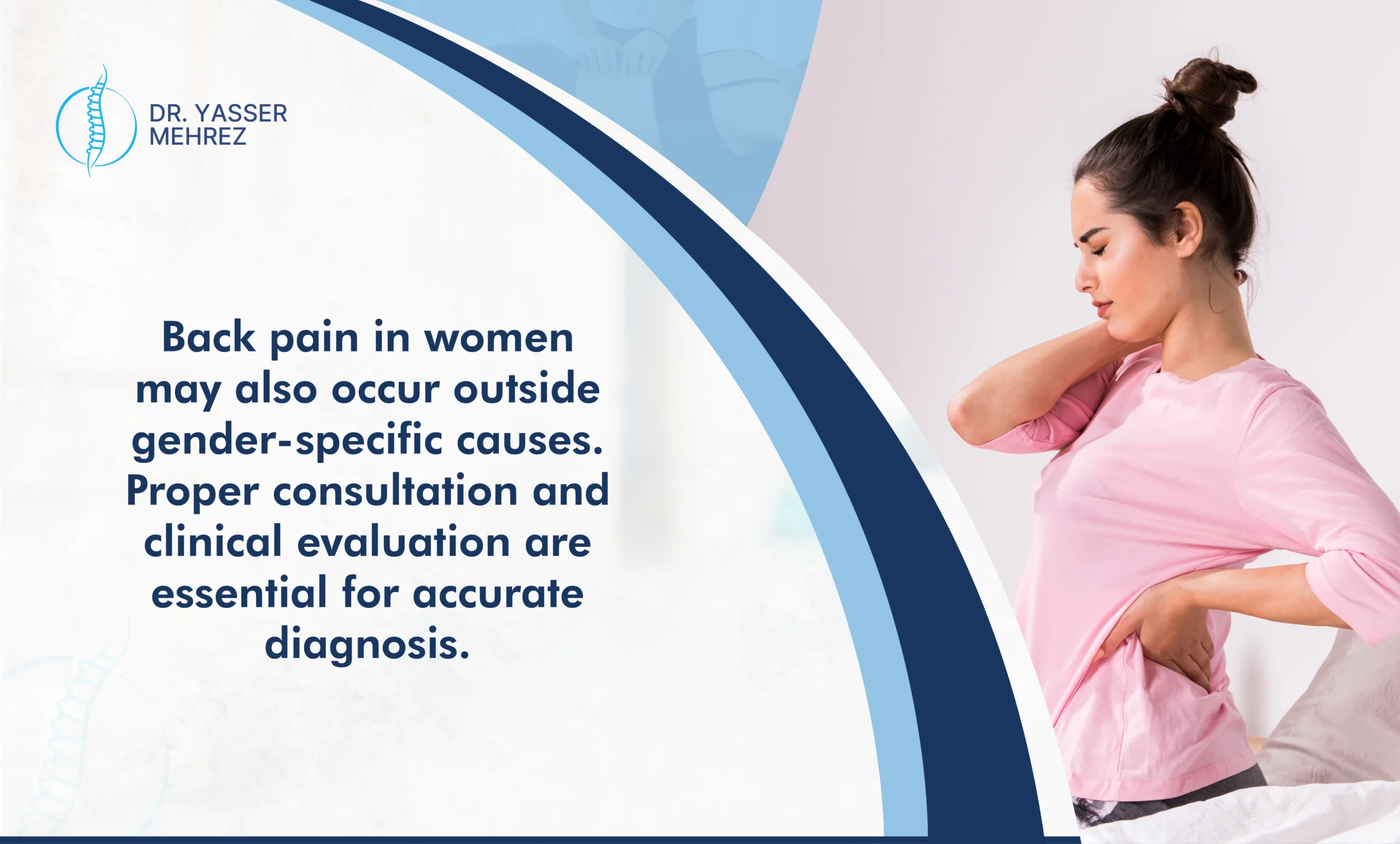
Other Causes of Lower Back Pain
Some other causes of lower back pain in all genders include:
Piriformis Syndrome
If your piriformis muscle goes into spasm, it can press on your sciatic nerve, sending pain down your leg.
You may experience more pain whilst sitting and standing for long periods. The pain location generally includes the lower back, buttocks, and legs.
Physiotherapy, muscle release techniques, and massage help people regain muscle function and relieve pain.
Spinal Osteoporosis
Osteoporosis affects many women and men after the age of 50. It is characterised by low bone mineral density (BMD) and weaker bones that are susceptible to fractures.
Even mild trauma or lifting something heavy could cause a fracture if your bones are weak.
These are called ‘fragility fractures’ — breaks that happen because your bones are not as strong as they used to be.
SI Joint Dysfunction
The sacroiliac joint is the connection between the sacrum (the spine’s last part) and the pelvis’s ilium (pelvic bone).
Generally, as a woman, you have a smaller SI joint surface, which puts more stress on it, causing misalignment. This imbalance of anatomical structures causes pain and discomfort.
SI joint pain may mimic sciatica due to nerve compression, causing sharp, stabbing pain around your buttocks, lower back, and leg.
Muscle Strain
Lower back pain is caused by usual muscle strain, which can result from overworking, prolonged sitting, sitting in an abnormal posture, or occupational stress.
Rest, gentle stretching, massage, and physiotherapy are treatment options.
What Can You Do at Home to Relieve Back Pain?
If your lower back pain is mild or occasional, you can manage it with simple home self-management techniques.
Adequate Rest
Avoiding tasks that worsen pain or resting for a specific time can significantly reduce your back pain.
Make sure not to stay immobile for more extended periods.
Hot or Cold Packs
If your lower back pain is caused by muscle strain, using hot packs can help relax muscles and reduce pain.
On the other hand, if the pain is due to trauma or inflammation, a cold pack is the best option.
Gentle Stretches
Stretching the strained muscles of your lower back may help reduce pain by providing relaxation.
Ensure correct stretch performance by learning from a healthcare professional or physiotherapist.
Postural Improvement
Sudden lower back pain can catch you off guard, often after lifting something heavy or twisting the wrong way.
These inaccurate positions create an imbalance in body biomechanics, causing severe pain and stress.
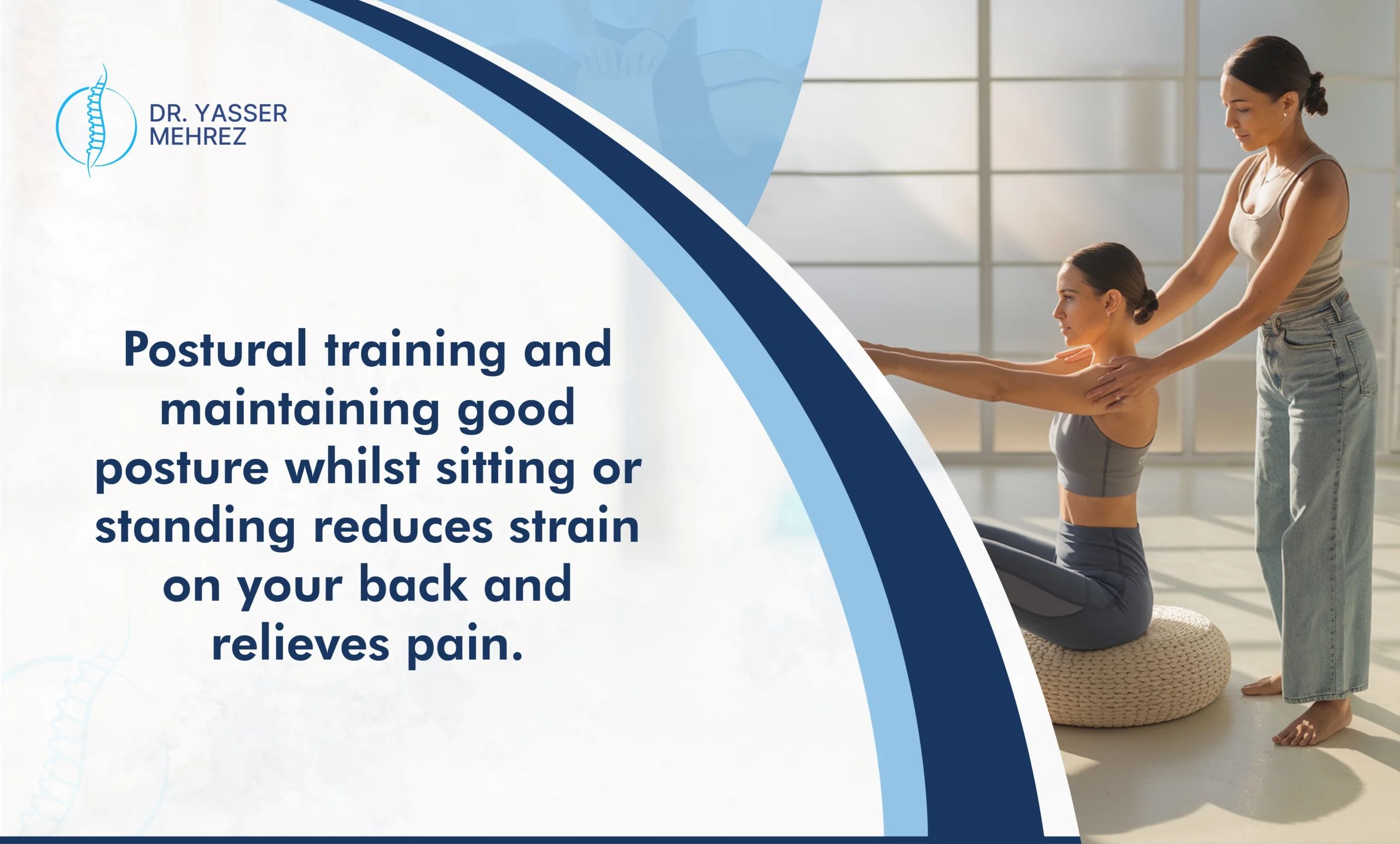
Over-The-Counter Painkillers
Taking OTC analgesics such as Tylenol, ibuprofen, and naproxen may help reduce pain temporarily. However, it is not recommended to take analgesics for long periods to avoid dependency.
Exercise Safety Guide
Performing exercises is not a one-size-fits-all treatment protocol. Everybody is different and responds differently to specific activities.
Here are some red flags that you should keep in mind whilst exercising:
- You feel sudden, sharp pain during movement
- You are unable to move in a specific direction
- You feel numbness, tingling pain with radiating symptoms
When Should You Contact a Doctor for Your Back Pain?
If you are trying self-management techniques for days without any gain, or if your back pain keeps coming back, it may be the right time to consult a doctor.
Pain that lasts a few days, increasing in severity or producing neurological symptoms, should be treated immediately by medical professionals.
Dr. Yasser Mehrez is a pain-management consultant in the UK who offers precise back pain treatment based on your symptoms.
Treatment Options for Chronic Low Back Pain
Although acute pain can be managed with simple lifestyle modifications and home remedies, chronic pain requires proper medical interventions.
Persistent lower back pain that doesn’t improve with rest may need medical attention to rule out any serious issues.
Epidural Injections
Epidural steroid injection is a non-surgical, popular pain relief option for back pain.
During this procedure, an anti-inflammatory drug is injected into your painful spinal level, causing short- or long-term pain relief.
Epidural injections are injected after careful assessment and diagnosis of your back pain.
Particularly reserved for chronic pain treatment when other options don’t work.
Radiofrequency Ablation
This is a minimally invasive procedure that uses heat to de-sensitise or disable the nerves responsible for sending pain signals from your lower back.
It’s usually recommended if diagnostic nerve blocks (test injections) successfully pinpoint the source of your chronic pain.
Dr Yasser Mehrez offers to deliver these treatment procedures with pinpoint accuracy.
If you’re experiencing constant lower back pain, it’s important to find out what’s causing it before it gets worse.
Contact Dr Yasser Mehrez today to schedule your appointment.
FAQs
How do I know lower back pain is serious?
Your lower back pain is serious if it persists for several days and causes numbness, tingling, weakness in one or both legs, loss of bowel or bladder control, unexplained weight loss, and fever.
How do I know if my back pain is muscle or organ?
Muscle pain often feels localised, stiff, and worsens with specific movements. In contrast, organ-related pain may be a deep, constant ache that radiates to other areas and is accompanied by symptoms like fever. For an accurate diagnosis, consult a doctor.
Why is back pain worse at night?
Night pain is generally considered a red flag. When lying down on your back, spinal pressure increases, causing pronounced symptoms. Poor sleep posture or underlying disc injuries can also cause nighttime pain.
